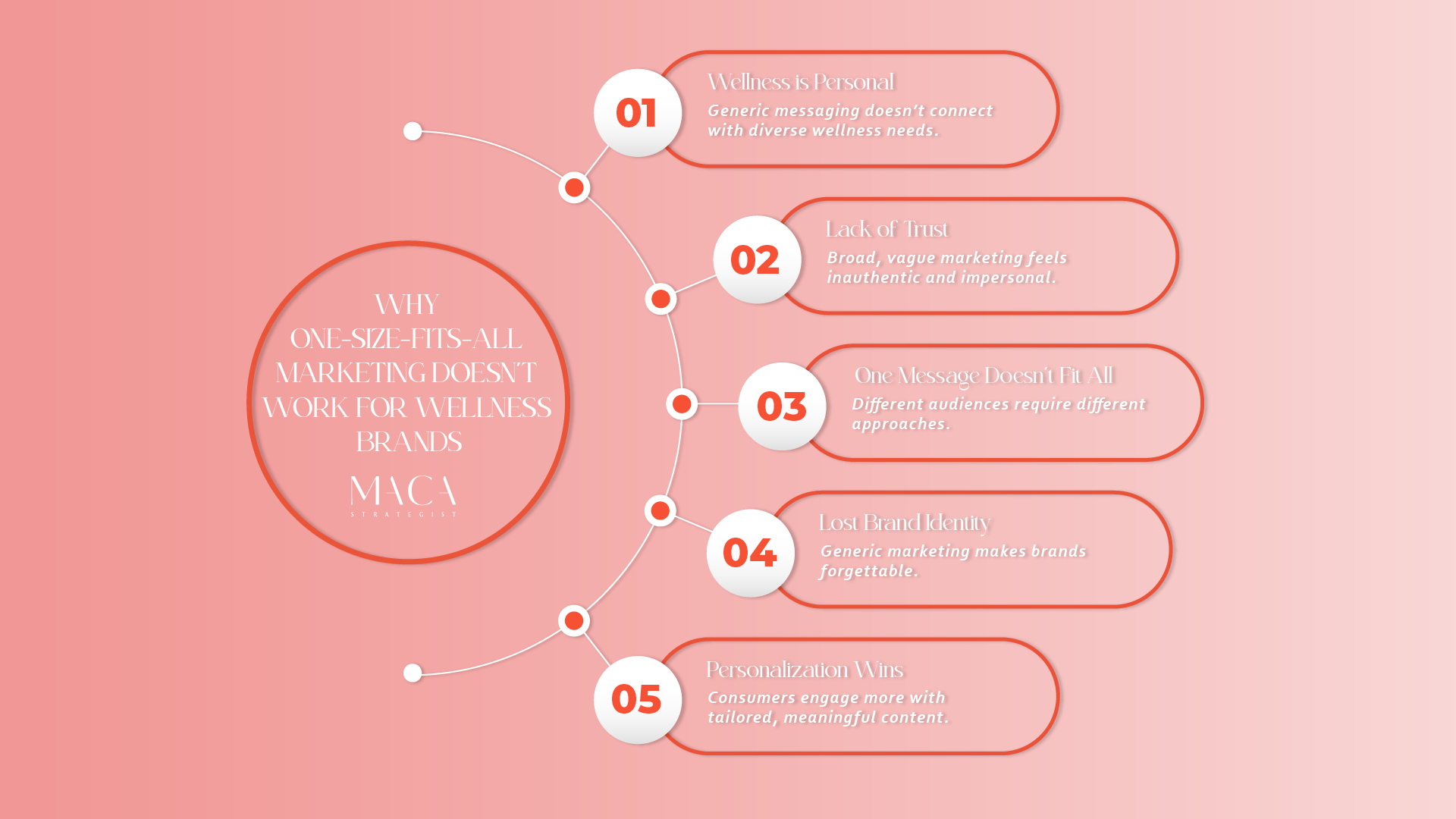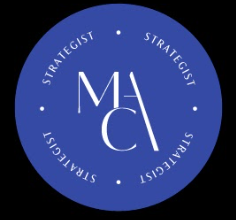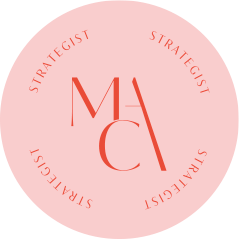The Problem with Generic Marketing in Wellness
Wellness isn’t one-size-fits-all.
For some, it’s about intense fitness training and performance optimization. For others, it’s about mindfulness, emotional well-being, or holistic healing. Some prioritize organic nutrition, while others seek out high-tech wellness solutions. The point? Wellness is deeply personal—driven by unique health goals, cultural beliefs, and lifestyle choices.
Yet, despite this diversity, many wellness brands still rely on generic marketing strategies—broad messaging, generic stock images, and vague promises of “better health” or “balance.” The result? They blend in, rather than stand out.
Why Generic Marketing Fails in Wellness
💡 It lacks connection.
When brands try to appeal to everyone, they end up resonating with no one. People crave personalization—they want to feel seen, heard, and understood. If your messaging is too broad, it fails to establish that essential emotional connection.
💡 It doesn’t build trust.
Consumers today are hyper-aware of marketing tactics. They can spot insincerity and inauthenticity from a mile away. Wellness is about trust, and trust is built when brands show they truly understand their audience’s needs—not when they throw generic slogans into the void.
💡 It dilutes brand identity.
Your brand has something unique to offer. But when your marketing is generic, you risk losing that distinctiveness. A yoga studio shouldn’t market itself the same way as a high-performance sports nutrition company. A holistic skincare brand should have an entirely different voice than a digital meditation app.
The Solution? Hyper-Personalized, Authentic Marketing
Instead of trying to be everything to everyone, successful wellness brands:
✅ Deeply understand their audience. They use real customer insights to craft messages that feel tailored and relevant.
✅ Leverage storytelling. They share real stories—of their founders, their customers, and the impact they’re making in the wellness space.
✅ Stay true to their niche. They embrace their unique brand voice and values, positioning themselves as thought leaders in their specific wellness sector.
The wellness industry is about transformation—helping people lead healthier, more fulfilling lives. Your marketing should reflect that. It should be personal, purpose-driven, and authentic. Because when a wellness brand truly connects, it doesn’t just gain customers—it builds a loyal community.

Wellness is Personal: Why Your Audience Rejects Generic Messaging
One-size-fits-all marketing doesn’t work in the wellness industry—because one-size-fits-all wellness doesn’t exist.
For one person, wellness might mean strength training and high-performance nutrition. For another, it’s daily meditation, herbal remedies, and energy healing. Some seek mental wellness tools, while others prioritize eco-conscious skincare or hormone-balancing supplements.
Trying to market to all these people with the same message? That’s a fast track to losing their interest.
Consumers today don’t just want products or services—they want to feel seen and understood. They crave solutions that align with their personal journey, lifestyle, and values. When brands fail to personalize their messaging, they risk blending into the background noise of a highly saturated industry.
Niche Audiences, Niche Messaging: The Key to Connection
Instead of broad, one-size-fits-all marketing, successful wellness brands embrace audience segmentation. They understand that wellness isn’t just one industry—it’s a collection of deeply personal experiences.
Here’s how smart brands tailor their messaging to different audiences:
🧘 Holistic Health Seekers → Messaging that emphasizes natural remedies, energy healing, and sustainable wellness practices.
💪 Fitness Enthusiasts → Campaigns centered around performance, recovery, and strength-building.
🧠 Mental Wellness Advocates → Content that speaks to stress reduction, mindfulness, and emotional resilience.
🌿 Eco-Conscious Consumers → Branding that highlights ethical sourcing, sustainability, and low-impact packaging.
Case Study: Personalization Drives Loyalty
A wellness brand specializing in herbal supplements struggled with low engagement. Their messaging was vague—”natural health solutions for everyone”—and their marketing approach was broad, failing to resonate with any specific audience.
What they changed:
✅ Created targeted content for different segments (stress relief for busy professionals, immune support for parents, and gut health for fitness lovers).
✅ Used customer-driven language, highlighting real testimonials and personal success stories.
✅ Partnered with NY wellness marketing experts to refine their brand positioning and develop an SEO-driven content strategy.
The result? A 65% increase in engagement, higher conversion rates, and a growing community of loyal customers who felt truly connected to the brand.
Personalization = Trust = Growth
The most successful wellness brands don’t try to speak to everyone. They focus on their unique audience, tailor their message, and create marketing that feels deeply personal. Because in the wellness space, true connection is what turns customers into lifelong advocates.
The Dangers of One-Size-Fits-All Marketing in Wellness
In an industry as personal as wellness, trying to appeal to everyone often results in connecting with no one.
Consumers today don’t want a general “feel-good” message—they want solutions that fit their unique needs. Whether they’re looking for hormone-balancing supplements, plant-based meal plans, or high-performance fitness coaching, they want brands that get them.
Yet, many wellness businesses make the mistake of casting too wide a net, hoping to attract as many people as possible. But here’s the truth:
🚨 If your brand tries to speak to everyone, it ends up speaking to no one.
The Risk of Diluting Your Brand’s Unique Value
Your wellness brand has something unique to offer—something that sets it apart. But when you use generic messaging like:
❌ “We help you live a healthier life!”
❌ “Feel your best with our wellness solutions!”
❌ “Balance your mind and body with our products!”
…it blends into the background. Consumers have seen it all before. They scroll past it because it doesn’t speak directly to them.
According to the Harvard Business Review, people trust brands that take a clear stand—whether it’s on sustainability, mental wellness, or inclusivity. Watered-down messaging doesn’t inspire action—it breeds skepticism.
How Generic Marketing Leads to Disengagement and Low Conversions
A one-size-fits-all approach in wellness marketing can lead to:
❌ Low engagement: People don’t feel personally connected to the brand.
❌ High bounce rates: Website visitors leave because they don’t see content relevant to them.
❌ Consumer distrust: Vague messaging makes customers question if the brand truly understands their needs.
A 2023 study by McKinsey found that 71% of consumers expect brands to deliver personalized interactions—and if they don’t, 76% get frustrated and move on.
Case Study: A Brand That Transformed Through Personalization
A wellness skincare brand struggled with declining sales and customer retention. Their branding was broad—promising “healthy, radiant skin for everyone.” But with an oversaturated market, their message wasn’t standing out.
🔹 The Fix: They revamped their strategy by segmenting their audience—creating targeted messaging for different skin concerns (acne, aging, sensitivity). They also partnered with influencers in each niche to strengthen trust.
🔹 The Result: A 40% increase in engagement and a surge in customer loyalty because people finally felt like the brand understood their specific skin needs.
The Takeaway: Focus on Depth, Not Width
💡 Instead of chasing everyone, focus on your ideal audience.
💡 Speak their language, understand their pain points, and craft a brand message that feels deeply personal.
💡 Learn from brands that successfully pivoted—those that made their marketing less about selling and more about connecting.
Because in wellness, trust is everything—and the brands that earn it are the ones that know exactly who they’re speaking to.
The Power of Personalization: How Wellness Brands Can Connect on a Deeper Level
In a world where people can customize everything—from their Spotify playlists to their vitamin regimens—why should wellness marketing be any different? Consumers today expect brands to speak directly to them, not at them.
Generic marketing is fading fast. The future belongs to targeted messaging, segmented campaigns, and hyper-personalized experiences. Brands that embrace personalization don’t just attract customers—they build trust, loyalty, and lasting relationships.
The Rise of Personalization in Wellness Marketing
✅ Consumers want to feel seen and understood.
A wellness journey is unique for everyone—what works for one person might not work for another. A fitness-focused audience needs different messaging than someone exploring holistic health.
✅ Personalized marketing leads to better engagement and conversions.
According to Forbes, businesses using personalized marketing strategies see up to a 20% increase in sales. When people feel like a brand understands them, they’re more likely to engage.
✅ AI and behavioral data are changing the game.
Smart brands are using data-driven insights to personalize messaging in real time. AI-powered tools track customer preferences, purchase history, and behavior to deliver the right content at the right moment.
How Wellness Brands Can Use Data to Tailor Their Messaging
📊 AI-Driven Recommendations:
Wellness apps like Noom and MyFitnessPal personalize nutrition and fitness plans based on user behavior. Brands can apply this approach to marketing by tailoring content based on consumer habits.
🎯 Segmented Email Campaigns:
Instead of sending the same newsletter to everyone, wellness brands can categorize their audience (e.g., yoga lovers, mental wellness seekers, eco-conscious shoppers) and send highly relevant content to each group.
🔍 SEO & Behavioral Insights:
Analyzing search trends and engagement data can help brands refine their messaging. Digital marketing for wellness NY experts specialize in leveraging data to create targeted marketing strategies that resonate with the right audience.
The Role of Storytelling: Why Real Stories Matter More Than Ever
💡 People don’t connect with products—they connect with stories.
A wellness brand that shares real customer transformations, founder journeys, or behind-the-scenes insights feels human—and that’s what builds trust.
🗣 User-Generated Content:
Encouraging customers to share their wellness journey (via reviews, social media, or testimonials) turns them into brand ambassadors.
📖 Authentic Brand Narratives:
Brands that openly share their mission and values create an emotional bond with their audience. A skincare brand, for example, that tells the story of why they chose clean ingredients is far more compelling than one that simply says “all-natural skincare.”
Actionable Steps to Personalize Your Wellness Brand’s Marketing
🚀 Use AI and customer data to tailor messaging.
📧 Segment your audience and send relevant content, not mass emails.
📖 Incorporate storytelling into every aspect of your brand.
🗣 Encourage and showcase real customer experiences.
The wellness brands that thrive in today’s market aren’t the ones that sell—they’re the ones that connect. Personalization isn’t just a strategy; it’s the foundation of authentic, lasting relationships with your audience.
Wellness Marketing That Works: Creating a Strategy That Feels Authentic
Consumers today are tired of robotic, overly promotional marketing. They don’t want to feel like they’re being “sold” to—they want to connect with brands that align with their values, understand their needs, and genuinely care about their well-being.
So, how can wellness brands create marketing that feels human, authentic, and deeply engaging? The answer lies in emotional branding, multi-channel strategies, and intentional storytelling that resonates with the right audience.
Why Authenticity is the Secret to Wellness Marketing Success
💡 People don’t just buy wellness products—they invest in lifestyles, beliefs, and values.
A consumer looking for organic skincare isn’t just searching for a moisturizer; they’re searching for a brand that aligns with their commitment to clean beauty and sustainability. A yoga enthusiast isn’t just looking for a class; they’re looking for a community that supports mindfulness and balance.
💡 Emotional connection builds long-term brand loyalty.
According to Harvard Business Review, consumers with an emotional connection to a brand are 52% more valuable than satisfied customers. This means authentic storytelling and values-driven marketing make a lasting impact.
💡 Wellness brands must shift from selling to serving.
The best wellness marketing doesn’t just showcase products or services—it educates, inspires, and empowers consumers on their wellness journey.
Multi-Channel Strategies: The Key to Authentic Wellness Marketing
Wellness brands that succeed take a multi-channel approach, integrating different marketing strategies to create seamless, engaging experiences.
🎯 Social Media & Community Engagement
- Create real conversations, not just polished ads.
- Leverage Instagram, TikTok, and Facebook groups for real-time engagement.
- Encourage user-generated content to highlight real customer experiences.
📖 Influencer & Thought Leadership Marketing
- Collaborate with wellness influencers who genuinely believe in your brand’s mission.
- Feature expert-backed content to build credibility.
📰 Public Relations & Wellness-Focused Campaigns
- Get featured in wellness publications, podcasts, and digital media to expand visibility.
- Use Wellness campaigns NY strategies that create buzz while staying true to your brand’s identity.
📝 SEO-Driven Content Marketing
- Publish blogs, case studies, and wellness guides that provide real value to your audience.
- Optimize content for search engines while keeping it engaging and educational.
How MACA Strategist Helps Wellness Brands Build Authenticity
At MACA Strategist, we don’t believe in cookie-cutter marketing. We believe in crafting customized, deeply human strategies that:
✅ Reflect your brand’s mission, values, and personality.
✅ Build authentic connections with your target audience.
✅ Integrate multi-channel marketing for maximum reach and engagement.
The wellness industry is more competitive than ever—but brands that prioritize authenticity, emotional connection, and strategic storytelling will always stand out.
Want to create a marketing strategy that feels real? Start today with a campaign that inspires, connects, and converts.
The Future of Wellness Marketing is Personal
Imagine walking into a wellness store where every product is labeled simply as “Good for You.” No ingredients, no benefits, no differentiation—just vague promises of better health. Would you trust it? Would you buy anything?
That’s exactly what happens when wellness brands rely on generic, one-size-fits-all marketing—they fade into the background, failing to create any real impact.
But here’s the good news: the future of wellness marketing is personal.
✅ Consumers want brands that understand them.
✅ They crave authenticity, not marketing fluff.
✅ They trust brands that listen, adapt, and engage in meaningful ways.
So, what’s the next step?
💡 Stop trying to speak to everyone. Instead, speak directly to the people who need what you offer.
💡 Ditch the generic messaging. Tell stories that connect, educate, and inspire.
💡 Move beyond just “selling” wellness—start building a brand that truly serves its audience.
The brands that embrace personalization, transparency, and emotional connection won’t just survive in the evolving wellness industry—they’ll thrive.
So, wellness brands, it’s time to ask yourselves: Are you just another option, or are you the solution your audience has been searching for?







